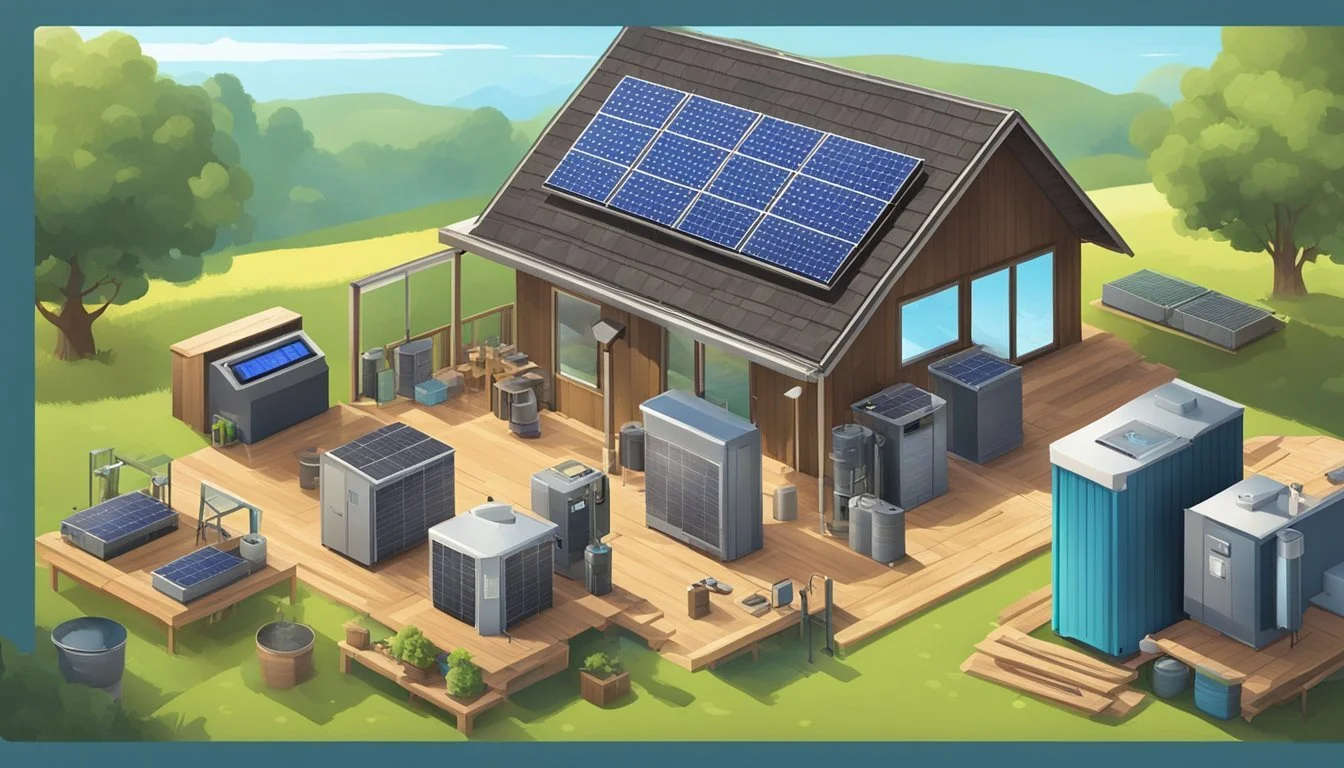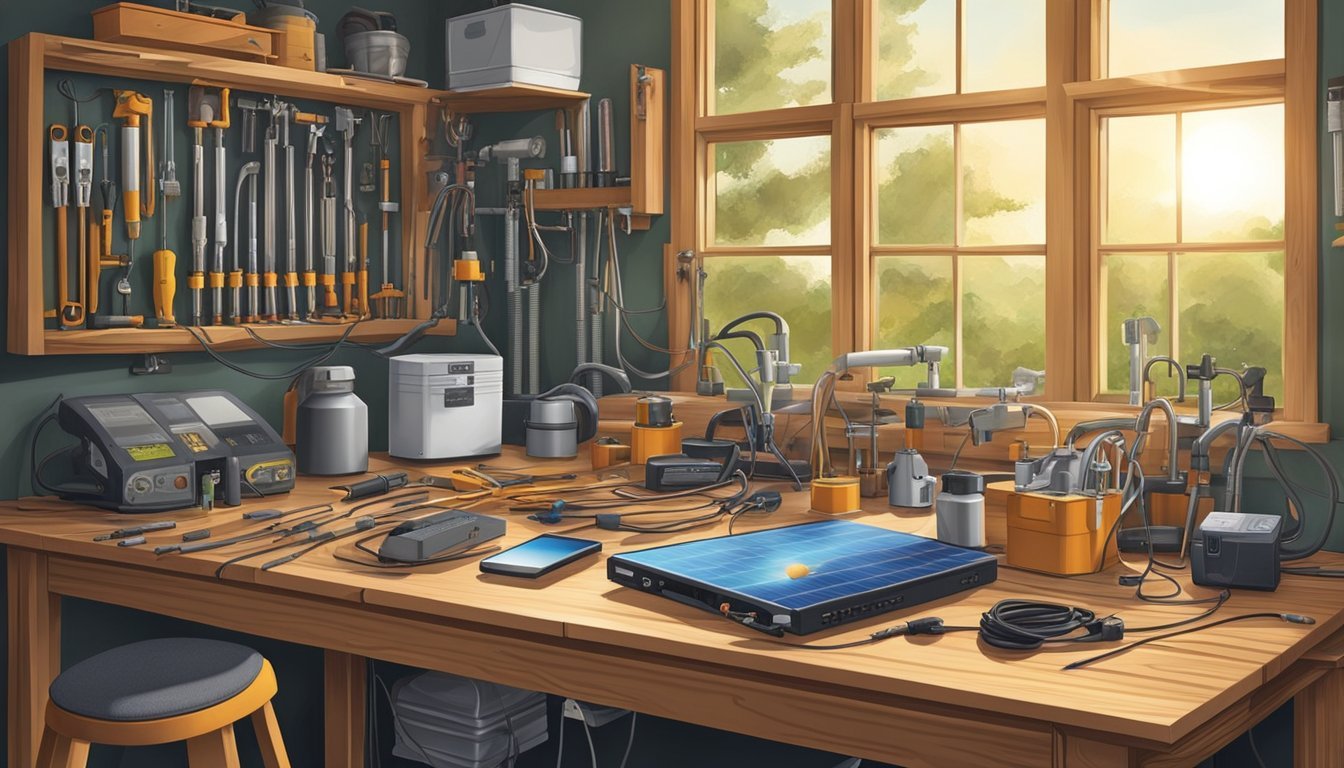The Ultimate Guide to Battery Chargers for Homesteaders
Essential Tips for Sustained Power
For homesteaders, the ability to maintain a reliable power source is essential for daily operations and efficiency. Battery chargers play a crucial role in this by ensuring that all battery-powered equipment is charged and ready for use. From the lights in a barn to the electric fences that keep livestock contained, a well-chosen battery charger can keep a homestead running smoothly. Equipment batteries, if properly charged and cared for, can drastically reduce downtime and improve the productivity of a homestead's operations.
Understanding the different types of battery chargers and how they function is vital for making an informed decision. Some chargers are designed to convert AC power to DC power for direct use and charging, while others are meant to maintain the batteries at optimum levels without overcharging. These devices vary greatly in sophistication, from simple trickle chargers that provide a steady, low level of power to more complex multi-stage units that can adjust the charge according to the battery’s conditions.
Choosing the right charger requires considering the specific needs of the equipment and the type of batteries in use. For instance, lead-acid batteries commonly found in solar power setups and vehicles on the homestead, require different maintenance compared to lithium-ion batteries used in power tools. The power source available will also dictate the choice of charger—whether it's grid power, generator, or solar. Therefore, homesteaders must evaluate their energy requirements and select a battery charger that provides reliability, efficiency, and longevity for their equipment batteries.
Basics of Battery Technology
In the realm of homesteading, understanding the fundamentals of battery technology is critical for ensuring that equipment remains operational and efficient.
Understanding Battery Types
Batteries come in various chemistries, each with specific advantages and use cases. Lead-acid batteries, including AGM (Absorbent Glass Mat) and gel batteries, are conventional and widely used due to their reliability and cost-effectiveness. They excel in providing a high surge current and are commonly found in automotive and solar applications. On the other hand, lithium batteries are recognized for their high energy density and longer lifespans. They typically exhibit higher milliampere-hour (mAh) ratings, indicating a greater capacity for energy storage in a smaller, lighter package.
Battery Capacity and Performance
Battery capacity is a measure of the energy a battery can store, commonly expressed in mAh or ampere-hours (Ah). For instance, a battery with a capacity of 3,400 mAh can deliver a current of 3,400 milliamperes for one hour. Performance is affected by temperature, discharge rate, and the number of charge cycles—a battery’s capacity may decrease over time as it is cycled through repeated charging and discharging.
Battery Type: Lead-Acid
Typical Capacities: 30-50 Ah
Battery Type: Lithium AA
Typical Capacities: 2,700-3,400 mAh
Battery Type: Lithium Homestead
Typical Capacities: 80,000 mAh (80 Ah)
Voltage, Current, and Electricity Basics
Voltage (V) is the potential difference that drives electric charge through a circuit, while current (I), measured in amperes or "amps," is the flow rate of this charge. For example, a 12V battery charging at 50mA would have a voltage of 12 volts and a current of 50 milliamperes. In battery chargers, circuits may utilize components like the LM317 voltage regulator to maintain a constant charge current, where resistance (R) in ohms (Ω) is calculated using Ohm's Law: ( R = \frac{V}{I} ).
Charging Equipment and Methods
To maintain the operational integrity of homestead equipment, a homesteader needs reliable battery charging equipment and methods. These range from standard chargers to more sophisticated power systems that leverage renewable energy.
Standard Battery Chargers and How They Work
Standard battery chargers provide a continuous, direct current (DC) to batteries. Typically, these chargers use AC power and convert it to a lower voltage suitable for battery charging. They follow a two-stage process: the first stage applies a bulk charge until the battery attains a pre-set voltage, followed by a float charge where the voltage is reduced to maintain the charge without overcharging.
Advanced Smart Chargers
Smart chargers are more technologically advanced, with the capability to monitor battery status. They adjust the current and voltage according to the battery's needs to prevent overcharging and overheating. These chargers may employ multi-stage charging that includes desulfation, to recondition the battery, bulk charge, absorption, and maintenance stages for optimum charging.
Solar Chargers and Solar Power Systems
Solar chargers and solar power systems convert sunlight into electrical energy using solar panels. A typical system includes solar panels, a charge controller, an inverter (to convert DC to AC), and a storage battery. The charge controller is crucial as it regulates the voltage and current from the solar panels to the battery.
Solar Panel Efficiency: Varies with panel types, common being monocrystalline and polycrystalline.
Charge Controller Types: PWM (Pulse Width Modulation) and MPPT (Maximum Power Point Tracking).
Alternative Charging Solutions: Wind and Generators
Apart from solar, wind turbines offer homesteaders an alternative renewable energy source. When integrated into a power system, they can serve as a standalone solution or a complementary source to solar. Generators, on the other hand, are powered by gasoline, diesel, or propane and are perfect for backup power, ensuring batteries remain charged during prolonged periods without sun or wind.
Charging Strategies for Homesteaders
Homesteaders rely on effective charging strategies to keep their equipment running. Maintaining battery health while optimizing charge cycles and providing off-grid power are key to reliable operation.
Optimizing Battery Charge Cycles
To maximize the efficiency of battery charge cycles, homesteaders should:
Ensure that they charge their batteries before they are completely drained; doing so can significantly extend the battery life.
Use a smart charger that automatically adjusts the charging time and rate to the battery's needs, preventing overcharging and energy wastage.
Maintaining Battery Health Over Time
For long-term battery maintenance, the following practices are recommended:
Regularly clean battery contacts and check for any signs of corrosion, which can impede the efficiency of energy transfer.
Store batteries in a cool, dry location to prevent deterioration of battery health that can occur in harsh conditions.
Off-Grid Charging for Remote Locations
For homesteaders in remote locations, off-grid charging solutions are critical:
Solar power systems can keep batteries fully charged using renewable energy, aligning with the principles of environmental sustainability and self-sufficiency.
An Enginstar 300 Watt battery or similar high-capacity, durable batteries with various power outlet options can serve as a central power hub for multiple charging needs.
By rigorously following these strategies, homesteaders can ensure that their batteries remain healthy and fully operational, supporting their self-reliant lifestyle.
RV Battery Charging Systems
Managing power efficiently is crucial for any homesteader with a recreational vehicle (RV). Properly charged batteries ensure that the RV's essential functions remain operational when off-grid.
Understanding RV Battery Needs
The heart of an RV's electrical system is its batteries. The deep-cycle RV batteries are designed to be discharged and recharged frequently. State of charge (SOC) is a vital metric indicating the remaining capacity of the battery. RV battery needs include a steady supply of power for motorhome appliances as well as house lighting and other systems. To keep these batteries in optimal condition, a robust charging approach is necessary.
Selecting an RV Battery Charger
When choosing a charger, one must ensure that it's compatible with the specific RV battery type. A suitable RV battery charger typically has a multi-stage charging process which includes bulk, absorption, and float stages. This ensures batteries are charged efficiently without being overcharged. RV owners should look for chargers that offer a maintainer mode, keeping batteries topped off without the risk of overcharging.
Charger Selection Criteria:
Compatibility: Must match battery type (AGM, Flooded, Gel, etc.)
Charging Stages: Preferably three-stage chargers (bulk, absorption, float)
Ampere Rating: Sufficient to charge batteries within a reasonable time frame
Integrating Solar Charging into RV Systems
Solar charging harnesses sunlight to maintain the charge of the RV house batteries, which is especially practical for remote locations without access to shore power. A well-configured solar system includes solar panels, a charge controller, and necessary wiring. The charge controller plays a pivotal role, preventing damage to the batteries from overcharging and allowing for a consistent charge regardless of sunlight level.
Solar System Components:
Solar Panels: Convert sunlight to electricity
Charge Controller: Regulates the voltage and current from the panels to the batteries
Batteries: Store electrical energy
By tailoring the RV battery charging system to the specific needs of their equipment and lifestyle, homesteaders can ensure a reliable power supply for their motorhome.
Preventing Common Battery Issues
Keeping equipment batteries properly charged is crucial for any homesteader. This section focuses on methods to prevent overcharging, sulfation, handle temperature extremes, and manage charging during less than ideal weather conditions.
Avoiding Overcharging and Sulfation
To avoid overcharging and sulfation, homesteaders should ensure their battery chargers have automatic shut-off features or voltage regulation. Chargers with temperature compensation are advantageous because they adjust the charging voltage based on the battery temperature, which can prevent overcharging. Periodic checking of specific gravity for lead-acid batteries can indicate sulfation, which is a buildup of lead sulfate crystals. To prevent sulfation:
Use a charger with a desulfation mode.
Avoid leaving batteries in a discharged state for extended periods.
Dealing With Temperature Extremes
Temperature extremes can adversely affect battery charging and performance. Batteries should be charged within their recommended temperature ranges, typically between 0°C (32°F) and 45°C (113°F). Temperature compensation built into chargers can prolong battery life by adjusting the charge rate according to temperature fluctuations. When dealing with cold weather:
Keep batteries insulated or inside.
Use a charger that adapts the charging algorithm for cold temperatures.
In hot climates:
Store batteries in cool, shaded areas.
Avoid charging at the peak heat of the day.
Managing Charging in Cloudy or Inclement Weather
For homesteaders relying on solar panels to charge batteries, cloudy days present a challenge. To ensure continued battery charging during cloudy or inclement weather:
Install a larger solar array to gather more light.
Use a high-quality, multi-stage charger that can maximize whatever power is available.
Additionally, consider backup charging methods such as wind turbines or generators to maintain consistent charging capabilities when solar is not an option. Proper planning ensures that batteries remain charged and ready for use, regardless of weather conditions.
Charging System Components and Setup
When setting up a charging system, homesteaders must select the correct components, configure stages and profiles, and maintain these systems to ensure peak performance and longevity for their equipment batteries.
Selecting the Right Components for Your System
Choosing the right components for a charging system requires considering the electrical system's needs and the battery capacity. For instance, a converter is essential for transforming AC to DC power. Homesteaders often use a multi-stage charger to ensure their batteries charge efficiently; these chargers switch between charging stages, such as bulk, absorption, and float charges. When dealing with different battery types, like flooded or lead acid batteries, it's crucial to select a charger that is compatible. For off-grid setups or areas with frequent power outages, solar generators are a sustainable option, while gas generators can offer a robust alternative.
Configuring Charging Profiles and Stages
Proper configuration of charging profiles is vital for maximizing battery life. Multi-stage charging involves an initial bulk charge, where the battery receives most of its charge at the highest current the charger can provide. Following this, the absorption stage allows the battery to reach full charge by reducing the current. Finally, the float charge stage maintains the battery at full charge without overcharging it. Each type of battery, be it flooded or sealed lead acid, has a specific charging profile that must be carefully set up in the built-in charger software to accommodate its unique needs.
Maintenance of Charging System Components
To ensure a charging system remains efficient, regular maintenance of its components is imperative. This includes inspection of cables for wear and connectivity, cleaning of terminals to prevent corrosion, and testing the system to verify correct function. For systems integrated with generators, routine checks are necessary to keep them ready for use. Additionally, keeping the firmware of multi-stage chargers up to date can improve efficiency and extend the operational lifespan of both charger and battery alike.
Accessorizing Your Charging System
In tailoring a charging system to the needs of homestead equipment batteries, selecting the right accessories ensures optimal charging and longevity. These include maintainers for steady charges, connections for diverse power sources, regulators for solar panels, and converters for alternating current appliances.
Utilizing Battery Tenders and Maintainers
Battery tenders and maintainers prolong the life of batteries by applying a trickle charge, which keeps a battery at full charge without overcharging. They are particularly useful for batteries in equipment that isn't used on a daily basis, monitoring voltage and providing charge accordingly.
Battery Tenders:
Ensure equipment is always ready for use
Prevent the natural discharge of batteries during storage
Battery Maintainers:
Ideal for long-term storage
May include solar options for sustainable charging
Connecting Multiple Power Sources
A charging system may connect to multiple power sources such as shore power when available or an alternator if using vehicle-based kits. This enables charging through different inputs while ensuring the equipment is not tied to a single power location.
Power Source Connections:
Shore Power: For reliable charging when stationary
Alternator: Takes advantage of vehicle motion to charge batteries
Incorporating Charge Controllers and Regulators
Charge controllers, which come as PWM (Pulse Width Modulation) or MPPT (Maximum Power Point Tracking), are essential for protecting batteries from overcharging, especially in solar panel setups. An MPPT charge controller is more efficient than a PWM controller, making it well-suited for larger solar systems.
MPPT Controllers:
Effective in varied temperature ranges
Ensure maximum efficiency of power transfer
PWM Controllers:
Simpler technology
Cost-effective for smaller systems
Using Converters for AC Appliances
Converters allow homesteaders to use alternating current (AC) appliances by converting the stored DC power from batteries into AC. They are crucial for running household appliances when off-grid and help in utilizing the power stored in the batteries efficiently.
Converter Usage:
Provides AC power from DC sources
Enables the use of common home appliances with battery banks
Advanced Topics in Battery Charging
Within the domain of battery charging, several advanced concepts significantly enhance the efficiency and effectiveness of energy storage for homesteaders. The development of technology, precise pairing of chargers with batteries, and tailoring solutions to meet specific needs are critical for optimizing battery charging systems.
Exploring Lithium-ion Technology and Applications
Lithium-ion batteries stand at the forefront of rechargeable power technology, offering high energy density and longer lifespans compared to traditional battery types. They are engineered to operate within the voltage range of typically 3.6V to 4.2V. A smart charger is essential for maintaining lithium-ion battery performance, as it adapts the charging speed and voltage to match the specific requirements of the battery, preventing overcharge and extending battery life.
Matching Batteries and Chargers for Optimal Use
For maximum efficiency, pairing the correct charger with a battery is crucial. The charger should provide the appropriate voltage and a compatible current (ampere) level to maintain optimal charging conditions. Batteries operate within certain voltage thresholds which if exceeded can cause damage. For example, a battery rated at 4.2V should be charged with a charger that matches this specification to ensure safe and efficient charging.
Designing Custom Charging Solutions for Unique Needs
In scenarios where off-the-shelf charging options are insufficient, custom charging solutions can be designed to meet unique requirements. These may incorporate multiple stages, such as a constant current phase where a fixed current is supplied initially, followed by a constant voltage phase to top off the battery. This is known as the CCCV charging technique, integral for achieving both a rapid charge and mitigating the risks of overcharging. Homesteaders can employ a tailored charging regimen that addresses individual battery bank capacities, environmental conditions, and specific energy consumption patterns.
Safety and Best Practices
To ensure longevity and reliability of equipment batteries, homesteaders must adhere to stringent safety standards and best practices which involve creating safe charging environments, following manufacturer’s guidelines, and conducting regular inspections and maintenance.
Ensuring Safe Charging Environments
The charging area must be well-ventilated, dry, and away from flammable materials. Chargers should be placed on non-conductive surfaces to prevent any risk of electrical shock.
Following Manufacturer's Charging Guidelines
Homesteaders should consult the manufacturer's manual for specific voltage and current settings. LiFePO4 batteries, for example, typically require a float voltage around 13.6V. Adherence to these guidelines ensures safe and efficient charging, maximizing battery lifespan.
Regular Inspection and Maintenance Routines
Routine checks of battery terminals for corrosion, and ensuring connections are tight and clean, are critical for preventing energy loss and safety hazards. Visual inspections can identify potential issues such as bulging, leaks, or odor that indicate battery damage.






